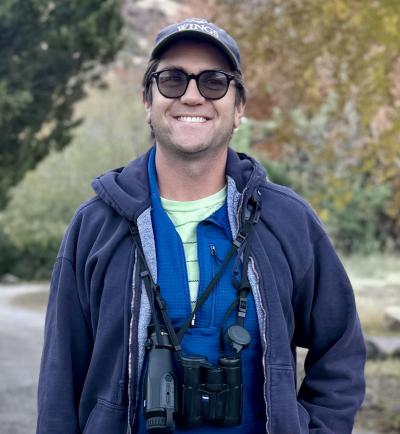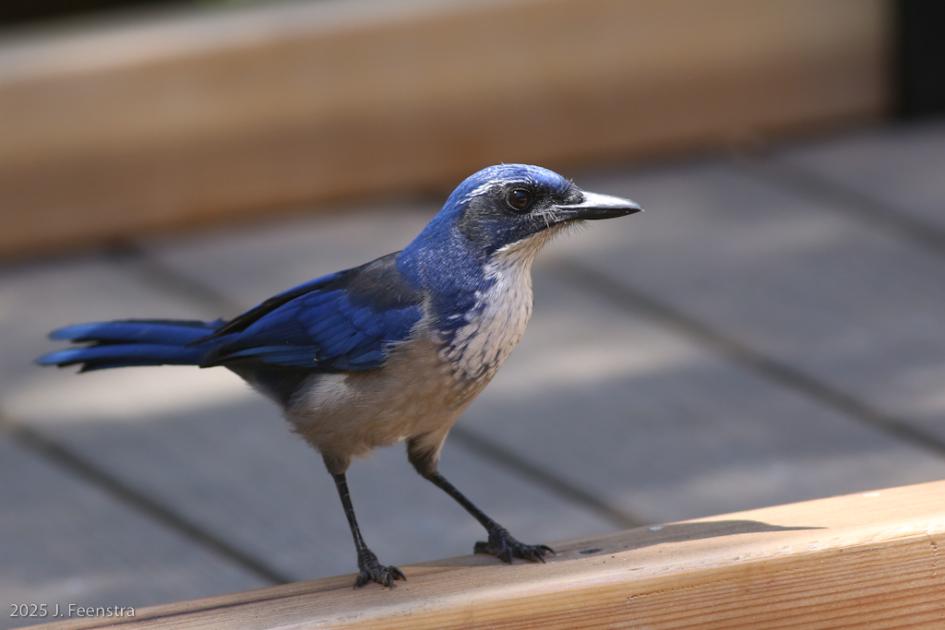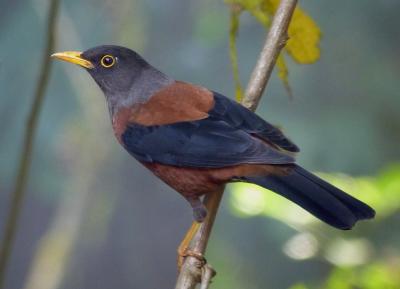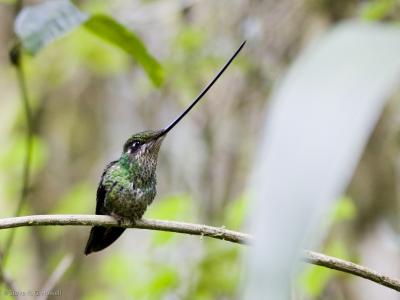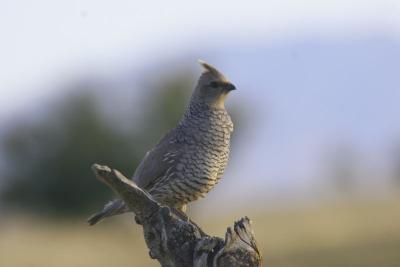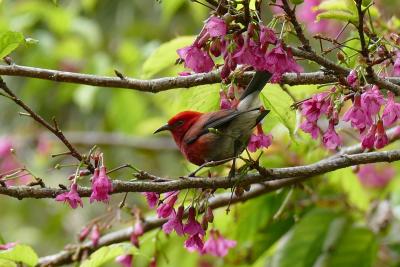California: Central and Southern
Pinnacles National Park, The Coast, Santa Cruz Island, the Salton Sea, and the Mojave Desert
-
Aug - Sep, 2027
Jon Dunn and Jon Feenstra
Central and Southern California may call to mind rampant development and crowds of people, but in fact it has many areas that are both wild and beautiful. We’ll focus on birds that are difficult or impossible to see elsewhere in the United States including the re-established California Condor and the endemics, Island Scrub-Jay and Yellow-billed Magpie. Our trip takes place at the start of the fall migration period for passerines, near the peak for migrant shorebirds, and is an excellent time for pelagics. Our route encompasses the coast and Santa Cruz Island northwest of Los Angeles, coastal areas south of Los Angeles, the legendary Salton Sea, the high conifer forests in the San Gabriel Mountains, and the Mojave Desert.
Day 1: The tour begins in San Jose at 6 pm with an introductory meeting followed by dinner. Night near the San Jose airport.
Day 2: After an early breakfast we’ll drive south to Pinnacles National Park. Along the way, in oak-savanna habitat, we’ll watch for Yellow-billed Magpie, a California endemic and one that has recently declined in range and numbers possibly due to West Nile Virus. We’ll stop at Pacines Reservoir, a place that can have waterbirds as well as White-throated Swift, Violet-green Swallow, maybe a Golden Eagle, and with very good luck a California Condor overhead. On a side road closer to Pinnacles, in the Chamise which covers the hillsides, we have a good chance of finding the darker nominate subspecies of Bell’s Sparrows. We also have an excellent chance for Lawrence’s Goldfinch and other chaparral species, particularly at water traps. Arriving at Pinnacles, we’ll scan the rocky outcroppings and overhead for California Condor. The last birds were taken from the wild in 1987 to breed in captivity, eventually enabling releases back into the wild, and this is one of the best places to see free-flying birds. Morning and late afternoon are the best times as during the day they fly off to forage. The east side of Pinnacles is surprisingly well-wooded, and we should encounter a variety of oak-woodland species possibly including California Quail, Acorn and Nuttall’s Woodpeckers, Hutton’s Vireo, California Scrub-Jay, Oak Titmouse, Bushtit (coastal subspecies), Wrentit, White-breasted Nuthatch (coastal aculeata subspecies with very different calls), Bewick’s Wren, Western Bluebird, and California Towhee. In rocky areas we’ll be alert for Canyon Wren and Rufous-crowned Sparrow, and we might find migrants such as Western Flycatcher, Lazuli Bunting, and a few warbler species. As we drive to King City, about 40-minutes away, we’ll watch for additional Yellow-billed Magpies and raptors. Night in King City.
Day 3: If our views of Condors were unsatisfactory, we’ll try again this morning. Otherwise (or later in the day), we’ll head south towards Morro Bay and coastal San Luis Obispo County. We’ll stop first at San Simeon State Park near where the coastal Monterey Pine forest reaches its southern limit. Here among the Bishop and Monterey Pines, distinctive subspecies of Brown Creeper, Pygmy Nuthatch and Dark-eyed (“Oregon” group) Junco are found in addition to other species such as Hairy Woodpecker, Chestnut-backed Chickadee, and Wrentit. The rocky coastline here is quite beautiful, and the creek mouths can have migrants, including rarities. Rocky shorebirds like Black Oystercatcher, Surfbird, Black Turnstone, and Wandering Tattler are all possible along with Brandt’s and Pelagic Cormorants. Perhaps we might find a Pigeon Guillemot although most will have migrated north to winter in the Puget Sound region of Washington. Later we’ll drive back to Atascadero where, after dinner, we might have a chance again to look for owls. Night in Atascadero.
Day 4: If we have missed Yellow-billed Magpie, we’ll search for it this morning in the beautiful oak grasslands east of Atascadero. Otherwise, we’ll return to the bird-rich Morro Bay area, stopping first at Laguna Lake to look for waterbirds and migrant land birds. In recent years the area at the east end of the lake has been good for the near California endemic, Tricolored Blackbird, and we’ll search for them among the flocks of Red-winged and Brewer’s Blackbirds. Cassin’s Kingbird and a variety of other species, including the introduced Scaly-breasted Munia, should be present, and along the reedy edge of the lake, we might see Green Heron and hear or see Least Bittern. At Morro Bay we’ll check the distinctive “Elfin Forest” where California Thrasher is found, and the Bay has good spots for migrant and wintering shorebirds. Near or at Morro Rock we should see Sea Otters near the mouth of the Bay and maybe a Peregrine Falcon roosting on the 23 million year-old Morro Rock, a volcanic plug and one of the stunning landmarks of the central California coast. Night in Atascadero.
Day 5: We’ll begin by searching for any species we missed in the Morro Bay/San Luis Obispo area before commencing the lengthy drive to Santa Barbara and Ventura. We’ll make a stop at Shell Beach where hundreds of Brandt’s Cormorants sit on rocky islets just offshore, and maybe a loon, or even a Humpback Whale will be visible. At nearby Oceano State Park, the riparian woodland will likely host a few migrants with the flocks of Bushtits and Chestnut-backed Chickadees. The jetties at Ventura Marina, where our hotel is located, are good backups for rocky shorebirds including Black Turnstone, Surfbird, and maybe a Wandering Tattler. Night in Ventura.
Day 6: We’ll spend the morning on a boat to Santa Cruz Island, the largest and most wooded of southern California’s Channel Islands. Once on the island we’ll explore on foot in search of the Island Scrub-Jay, a California and Santa Cruz Island endemic. Sadly, its population has declined in recent years, perhaps also a result of West Nile virus or of predation on the young by the resurgent Island Fox population. Resident species will likely include the distinctive sounding, largely resident sordida subspecies of Orange-crowned Warbler that can be found on the Channel Islands and a few points along the adjacent mainland. Although transport across the Oxnard Channel is on a high-speed catamaran, we’ll hope to see a few pelagic birds possibly including Pink-footed, Sooty, and perhaps Black-vented Shearwaters, and Pomarine and Parasitic Jaegers. Marine mammals including whales are also possible. Along the jetties around the marina, we’ll search again for any rocky coast shorebirds we’ve missed. Night in Ventura.
Day 7: We’ll do a bit of birding in the Ventura area, checking first around the hotel grounds for Allen’s Hummingbird. Nearby Sycamore and La Jolla Canyons might have migrants and a population of the introduced, sycamore-loving Nanday Parakeets which inhabit the south facing canyons in the Santa Monica Mountains. Rufous-crowned Sparrow might be present as well. A very private duck club near neighboring Point Mugu is one of California’s best spots for migrant shorebirds. Access is restricted but thanks to friends we’ve had good luck arranging a visit. Scarcer species like Baird’s, Solitary, and Pectoral Sandpipers, and Ruff are of nearly annual occurrence, and phalaropes are often abundant, mainly Red-necked but sometimes Wilson’s as well. We usually hear and sometimes see Sora and Virginia Rail. After lunch, we’ll drive east and north to California City in the heart of the Mojave Desert. Night in California City.
Day 8: Our main target is LeConte’s Thrasher, a few of which are found in the area. Also present are Bell’s Sparrow, the paler canescens subspecies limited to the Mojave Desert and the western fringe of the San Joaquin Valley. Migrants should be present around Central Park and in clumps of trees around ponds on the golf course. We might also be able to locate a roosting American Barn Owl. Night in California City.
Day 9: We’ll bird around California City for lingering migrants, or possibly head north to the spectacular Nine Mile Canyon on the east side of the Sierra Nevada Mountains. Here we might see Pinyon Jay and at least have a chance for Chukar. With excellent luck we might even encounter a covey of Mountain Quail. In some years a roosting Long-eared Owl can be found near the Mojave Desert area of Ridgecrest. After lunch we’ll head south towards the San Gabriel Mountains. Night in Wrightwood.
Day 10: We’ll explore parts of the San Gabriel Mountains where we should see species typical of the coniferous forest including Red-breasted Sapsucker, White-headed Woodpecker, Steller’s Jay, Mountain Chickadee, Pygmy Nuthatch, Western Bluebird, and Purple and/or Cassin’s Finch. Both Green-tailed Towhee and the distinctive appearing and sounding “Thick-billed” Fox Sparrow nest here. Migrants should be present too and we’ll search the feeding flocks for Hermit Warbler, which prefers pines at all times of the year. Scarcer species we might see include Williamson’s Sapsucker, Clark’s Nutcracker, and Townsend’s Solitaire. Later in the day we’ll drive east and south to the Salton Sea. Night in Westmorland near Brawley.
Day 11: The Imperial Valley and the Salton Sea may test our endurance. Early September can be blazingly hot, but our birding will be confined primarily to the early morning and late-afternoon hours. The primary ornithological attraction is Yellow-footed Gull, one of the world’s rarest gulls and a post-breeding visitor from the Gulf of California. Salton Sea is its only regular location in the U.S. but sadly numbers have greatly declined over the last decade due to low water and diminished food; only very small number now travel inland to the Sea. Other birds may include Least Bittern, Inca Dove, Lesser Nighthawk, Costa’s Hummingbird, Gila and Ladder-backed Woodpeckers, Black-tailed Gnatcatcher, and Abert’s Towhee. We’ll also search for the yumanensis subspecies of Ridgway’s Rail and there should as well be a variety of migrant landbirds. Night in Westmorland.
Day 12: We’ll spend a few hours birding in the Imperial Valley looking for any species we may have missed before driving to Mission Bay, San Diego. Night in San Diego.
Day 13: We’ll join a public pelagic trip out of Mission Bay and about 30 miles offshore. We are likely to see Pomarine and Parasitic Jaegers, Black and Leach’s Storm-Petrel, the latter including darker rumped chapmani subspecies which breeds on Mexico’s Islas Coronados Islands, and Black-vented and Pink-footed Shearwaters. Species we might see include Sabine’s Gull, Arctic Tern, Least and perhaps Townsend’s Storm-Petrels, Craveri’s, and with very good luck, Guadalupe Murrelets, and perhaps even a Red-billed Tropicbird. Night in San Diego.
Day 14: We’ll search for the endangered California Gnatcatcher, found very locally around San Diego. Other possible species include chaparral species like Wrentit and California Thrasher. At the Tijuana River Estuary National Wildlife Refuge, Ridgway’s Rail (subspecies levipes) are found along with the very blackish beldingi subspecies of Savannah Sparrow. San Diego has a decent migration, and we’ll search areas where there should be a variety of migrants. To the east at El Cajon is a large Amazon parrot roost containing mostly introduced Red-crowned and a few Lilac-crowned Amazons. We’ll close the day with what we hope will be a fine meal at a local seafood restaurant. Night in San Diego.
Day 15: The tour concludes this morning in San Diego, with the leaders shuttling participants to the airport.
Note: The information presented here is an abbreviated version of our formal General Information for Tours to California. Its purpose is solely to give readers a sense of what might be involved if they take this tour. Although we do our best to make sure that what follows here is completely accurate, it should not be used as a replacement for the formal document which will be sent to all tour registrants, and whose contents supersedes any information contained here.
ENTERING THE UNITED STATES: Non-U.S. citizens need a valid passport and may need a tourist visa. Consult your nearest U.S. Embassy or consulate for details.
Canadian citizens should carry proof of citizenship in the form of a passport. If required by the embassy or visa-granting entity, WINGS can provide a letter for you to use regarding your participation in the tour.
PACE OF TOUR: This tour has some long days and some pre-dawn starts. The early starts result because of the heat in southeastern California and also because of our ornithological targets. There is some hiking, but none of the walks are strenuous.
HEALTH: California presents no real hazards to the visiting birdwatcher.
Altitude: We will reach about 7,000 feet in elevation.
Sun and Dehydration: The California sun can be intense, particularly in the south, on the water, and at high elevations; adequate skin protection is essential. Be sure to have water with you at all times.
Smoking: Smoking is prohibited in the vehicles or when the group is gathered for meals, checklists, etc. If you are sharing a room with a nonsmoker, please do not smoke in the room. If you smoke in the field, do so well away and downwind from the group. If any location where the group is gathered has a stricter policy than the WINGS policy, that stricter policy will prevail.
Miscellaneous: Insects are generally not a problem, but may be locally present at or near the Salton Sea, and possibly elsewhere.
Mammals, reptiles and other creatures do not constitute a hazard and we actively search for them during the trip.
In the desert one could have a nasty encounter with cactus if not watchful.
Finally, the Pacific is often not smooth and participants should bring their preferred motion sickness medication for the pelagic trips.
CLIMATE: California weather is extremely variable. Temperatures of up to about 115°F may occur in late summer, but you must also be prepared for cool mornings (50s F) along the coast or in the mountains. Rain and wind are unlikely except as local thundershowers in the desert.
ACCOMMODATIONS: We will be staying at standard, comfortable motels during the trip. WiFi is available at all our accommodation.
FOOD: Food on the tour will be a diverse range of cuisines mostly at casual-dining restaurants, except for the restaurant at our lodging in San Diego which is closer to fine-dining. Cuisines might include Mediterranean, Asian, Mexican, and American cuisine. WINGS tours are all-inclusive and no refunds can be issued for any missed tour meals.
Food Allergies / Requirements: We cannot guarantee that all food allergies can be accommodated at every destination. Participants with significant food allergies or special dietary requirements should bring appropriate foods with them for those times when their needs cannot be met. Announced meal times are always approximate depending on how the day unfolds. Participants who need to eat according to a fixed schedule should bring supplemental food. Please contact the WINGS office if you have any questions.
TRANSPORTATION: We will be traveling by 15-passenger window van or minivan, depending on the group size. On a few occasions a local guide will likely travel in the vehicle with us for a short portion of the tour. Participants should be able to ride in any seat in tour vehicles and are expected to change seats with others daily.
2025 Narrative
In Brief
Our Central and southern California tour recorded some 234 species. These included all of the chaparral specialties, Ridgway’s Rail, Prairie Falcon, Island Scrub-Jay, Yellow-billed Magpie, Prairie Falcon, Lawrence’s Goldfinch (many!), a wide variety of shorebirds, including rarer species such as Pacific Golden-Plover and Baird’s, Semipalmated and Solitary sandpipers, California Gnatcatcher, LeConte’s Thrasher, and Tricolored Blackbird. In the mountains we located White-headed Woodpeckers and Pinyon Jays, a surprising Northern Pygmy-Owl, and briefly glimpsed the always elusive Mountain Quail, and at the Salton Sea located three of the rapidly decreasing (to California) Yellow-footed Gull, a Sea of Cortez endemic. At sea off San Diego we managed to locate a wide variety of pelagic species including Craveri’s Murrelets and Least and Townsend’s storm-petrels, as well as Cocos Booby, and a rare Flesh-footed Shearwater. We saw two re-established California Condors at Pinnacles N.P. Rarities included a Purple Martin and an immature male Prothonotary Warbler. Another stand was a superbly seen Sperm Whale.
In Detail
After an evening meeting and dinner close-by at the Province in San Jose, we arose early the next morning and after breakfast headed south towards San Benito County where at Paicines Reservoir we met Debra Shearwater and her friend MK Wilcox, who worked at the nearby Paicines Ranch. The owners of the ranch also owned the reservoir which they gave us access to. Here we had 110 American White Pelicans and a variety of shorebirds which included a juvenile Lesser Yellowlegs. Two Cassin’s Kingbirds, White-throated Swifts (our only ones) and a few Violet-green Swallows were present too and here and at the nearby ranch we noted a White-tailed Kite, a Golden Eagle and most notably a Prairie Falcon which we saw well. We checked through a large group of Red-winged Blackbirds (“Bicolored” group, subspecies mailliardorum). From here we continued south towards Pinnacles National Park, noting an adult Bald Eagle perched along the way. Before reaching Pinnacles N.P, we headed west at Gloria Road. This road ultimately reaches the Salinas Valley. After a few miles we noted lots of birds at a flowing sprinkler. Most were Lawrence’s Goldfinches! This beautiful species is usually elusive in California (where most occur) away from the breeding season. Here, and especially at a roadside pond up the road, we had excellent studies of the dark nominate belli subspecies of Bell’s Sparrow. They were actually common here! Other species noted included California Quail (lots), Oak Titmice, Bushtits, Nuttall’s Woodpecker, California and Spotted Towhees, a pair of Hutton’s Vireo, and a dull Lazuli Bunting. Acorn Woodpeckers seemed to be everywhere. A single Merriam’s Chipmunk and numerous Mule Deer were also seen along with a striking butterfly, the California Sister.
Arriving at Pinnacles National Monument we decided first to have lunch in the picnic area. Here we noted aculeata White-breasted Nuthatches (from the Pacific group which have distinctive vocalizations) and after lunch we observed two California Condors soaring over the ridge to the south. The last individuals were removed from the wild on Easter Sunday, 19 April 1987, but after successful captive breeding, birds were released back into the wild. The Pinnacles area is one of the best places to see this species in the wild. Nearby, at Bear Gulch we had excellent views of Wrentit, a Western Flycatcher, and single Bewick’s and Canyon Wrens. As we drove south towards King City we stopped to admire a number of Yellow-billed Magpies, an endemic and declining species in California. Two Loggerhead Shrikes, another declining species, were seen during the day. A single migrant Yellow Warbler was our only wood warbler. We had dinner at the Cork and Plough in King City.
Having seen both California Condor and Yellow-billed Magpie well, we headed south on US 101 the west on state highway 46 for the Morro Bay area. At the rest stop near the San Luis Obispo County line we had nice studies of Lark Sparrows. From Paso Robles, we headed west towards San Simeon, the location of famous Hearst Castle, one of the “homes” of William Randolph Hearst. The construction, started in 1919, was never fully completed as its owner had to leave the estate due to his declining health in 1947. The coastline there is beautiful and largely unoccupied. Upon reaching Cambria, we noted a disabled Great Horned Owl on the roadside. Jon F. was able to reach a rehab center and after more calls someone was able to pick up the bird. Sadly, it didn’t make it. We stopped next at the San Simeon Pier where we had excellent views of a Red-throated Loon which no doubt summered here. Here we also had two Pigeon Guillemots, a breeding species, but by September, most birds have departed north. Most winter around Puget Sound in Washington. A single “Pacific” Bottlenose Dolphin was noted. At San Simeon State Park we walked a forest trail near the southern end of the unique coastal forest with its Bishop and Monterey pines. This forest is confined to coastal central California. Here there are endemic subspecies of Brown Creeper (philippsii, with buffier underparts) and Pygmy Nuthatch (nominate pygmea, with buffier underparts and significantly reduced black in the face and different calls). We saw both of these species as well as Chestnut-backed Chickadees (subspecies barlowi with no rufous on the sides) and a bright male chryseola Wilson’s Warbler. After a picnic lunch near Morro Bay we birded nearby Morro Creek where a Neotropic Cormorant was known to be present. It arrived soon after we started birding there. This species has been spreading north over the last two decades and has just reached Central California. At Morro Bay there were flocks of Heermann’s and Western Gulls along with some Elegant Terns and one Royal Tern. Brandt’s and Double-crested Cormorants along with a single Pelagic Cormorant were also present which completed a quartet of cormorant species for the day. A Long-billed Curlew and Whimbrel were noted too. A juvenile Reddish Egret, rare in California, especially this far north, was watched feeding across the bay. We also admired Sea Otters and California Sea Lions. Our last birding was done along the east side of Morro Bay where we checked for a juvenile Stilt Sandpiper at Turi Ponds. We did not see it but did see a rare and late juvenile Semipalmated Sandpiper which Jon F. spotted. Some 15 Red-necked Phalaropes were also noted. Two Peregrine Falcons were seen during the afternoon. Dinner that evening was at the Guest House Grill in Atascadero.
We started our next morning at Laguna Lake, where on the east side, our best sighting was a half dozen Tricolored Blackbirds scattered with the blackbird flock. We have missed this species on the past several tours. This highly colonial species has declined catastrophically in recent years in California where nearly all are now found. They are certainly threatened. We also noted two Botta’s Pocket Gophers. On the west side of the lake, we heard a single Least Bittern and a Virginia Rail. Cinnamon Teal and Violet-green Swallows were also present. From there, we headed back to Morro Bay and found the single juvenile Stilt Sandpiper. An adult Bald Eagle was again perched on its rock on a hill. At the Elfin Forest in Los Osos we had excellent studies of California Thrashers. A single perched juvenile Purple Martin (western subspecies arboricola) on a Monterey Cypress was a fall migrant and was quite unusual for the area. A flock of Band-tailed Pigeons in Los Osos were also well studied. Species seen around Morro Bay included a Clark’s Grebe, Black Oystercatcher (9), Black Turnstone, and numerous Marbled Godwits and Elegant Tern. A single immature (one year old) Glaucous-winged Gull was at Morro Rock. Dinner that night was at Chitose, a Japanese restaurant in Atascadero.
The next morning we returned to Laguna Lake where we studied a single male Tricolored Blackbird and searched for migrants. Cassin’s Kingbirds were numerous, and we saw a dozen. We had Orange-crowned and Wilson’s Warblers, a Willow Flycatcher, several Belted Kingfishers, a heard-only White-breasted Nuthatch, along with a Western Warbling-Vireo, newly split from Eastern Warbling-Vireo, which is appropriately found in the East. Scaly-breasted Munia, an introduced species from southern Asia, was numerous. We also had distant views of three perched Golden Eagles. We continued on south noting a small group of Wild Turkeys, and made a quick stop on the rocky coast at Shell Beach where we studied hundreds of Brandt’s Cormorants perched. We then moved on to Oceano State Beach where we noted a family group of Hooded Orioles, two migrant Black-headed Grosbeaks, Chestnut-backed Chickadees, a pair of Hutton’s Vireos, a single White-breasted Nuthatch (excellent views), a California Thrasher, Common Yellowthroats, and Orange-crowned, Yellow, and Wilson’s warblers. We also studied several Brush Rabbits, a darker and less numerous relative of the Desert Cottontail. After lunch at Dune Side Deli, we continued south to Ventura. Our final stop was at Ventura Marina where our hotel was located. We checked the rocky jetties where we noted a hybrid American x Black Oystercatcher and several Black Turnstones. Dinner that night was at Chef Kazos (Mediterranean food).
The next morning was an Island Packers pelagic trip to Santa Cruz Island. In the marina we noted several Yellow-crowned Night Herons, a species which was first recorded in 1962. On the rocky breakwaters we noted several Surfbirds and a single Ruddy and a number of Black Turnstones. We then headed into a fog bank, so pelagic sightings were very few. Arriving at Scorpion Cove on Santa Cruz Island most of the passengers departed. We continued on to Prisoners Harbor where we disembarked. The location is named for a group of prisoners that were “dumped” there by a Mexican boat (California did not break away from Mexico until 1848 after the Mexican War). Facing starvation many months later after a fire which burned a shed housing the provisions, they built a raft and were able to reach the mainland where they were promptly arrested! Importantly for birders the oak woodland reaches the coast here, so Island Scrub-Jays, an endemic species on Santa Cruz Island, are numerous. We found them easily and had excellent close views. They are very closely related to coastal birds but are larger overall with a bigger bill and a deeper blue coloration which spreads to the undertail-coverts as a wash. Their calls are hoarser. California Sister butterflies were present too. The most numerous bird species was Orange-crowned Warbler which seemed to be everywhere. Many were singing, their songs being variable and distinctive from other mainland subspecies. This is the mainly resident sordida subspecies which is largely restricted to the Channel Islands off southern California. On the return trip, and under clear skies, we noted over 500 Black-vented Shearwaters along with smaller numbers of Pink-footed and Sooty shearwaters. Small numbers of Red-necked Phalaropes were also noted along with a single Pomarine Jaeger. Upon returning to Ventura Marina, we had somewhat distant views of a Wandering Tattler. Single Clark’s and Western grebes were also present. Marine mammals seen on the return included a large pod of Common Dolphins, along with three Humpbacks and a single Minke whale. A single Common Murre was seen briefly. Dinner that night was at Back Bench Pizza in downtown Ventura.
Much of the next day was mainly spent driving. We birded in the morning on the Ventura County coastline. We started with Allen’s Hummingbirds at the flowering honeysuckle in the hotel parking lot, then returned to the jetty where we got scope views of a single Surfbird and five Black Turnstones. From here we headed south down the coast to Sycamore Canyon where we saw Wrentits and numerous California Towhees along with a single Blue-gray Gnatcatcher. This is a good spot to see introduced Nanday Parakeets, but we only just heard them! In Southern California they are attracted to sycamore canyons and are mainly found in the south facing canyons of the Santa Monica Mountains. At nearby La Jolla Canyon we got good studies of a Rufous-crowned Sparrow. Nearby we met Larry Sansone at the private Ventura County Game Reserve, and he led us on a tour of this remarkable reserve, famous for its shorebird concentrations. It is a private hunting club for waterfowl and is only open to its members. Only a few are allowed permission to bird the grounds. Fortunately, he can bring guests with advance permission. We were not disappointed and tallied some 250 Red-necked Phalaropes along with 55 Lesser Yellowlegs, nearly all juveniles. Scarcer (uncommon to rare) species included juveniles of both Baird’s and Solitary sandpipers. The Solitary Sandpipers were western cinnamomea with rich buffy (not white as in eastern solitaria) dorsal spots. Long-billed and Short-billed dowitchers were carefully compared. A single and slightly late Wilson’s Phalarope was our only one of the tour. Also seen were some 25 White-faced Ibis and both Sora and Virginia Rail along with Marsh Wrens (western subspecies group which sing quite differently from the eastern group) and Savannah Sparrows. Last, but not necessarily least, was a striking male Ruddy Shelduck, presumably an escape, but the origin issues are complex. Presumed wild birds, including flocks, have reached Scandinavia, Iceland, western Greenland, and Southampton Island north of Hudson Bay, so the records need to be archived and perhaps revisited at some point. The records in from Iceland and Greenland (four recorded!) were in 1892, an invasion year in Western Europe. I submitted the record to the California Bird Records Committee for consideration, but mainly so that the information will be archived. This bird was found on 22 August and was last seen on 7 September. After lunch at Jersey Mike’s, we headed east towards the Mojave Desert, arriving at our hotel late in the afternoon in California City. Holly took care of us at dinner at the Green Tea Garden.
After breakfast the next morning we studied hummingbirds in the flowering trees out the front door. These included presumed Rufous along with Black-chinned and Costa’s. A Verdin was also seen. Our main goal of the morning was LeConte’s Thrasher which is resident at the north edge of town in what was prime habitat. Unfortunately, a fire had burned a large section of the habitat. Still, we did manage to locate a pair of thrashers and eventually obtained good scope views. We also saw a number of Bell’s Sparrows. These were the paler subspecies, canescens, which prefers more arid habitats than the belli subspecies we had seen earlier near Pinnacles National Park on our first birding. A single Brewer’s Sparrow was also seen. We next birded around California City’s Central Park where there was a scattering of migrants (Western Wood Pewee, Willow Flycatcher, Blue-gray Gnatcatcher, Orange-crowned and Yellow warblers, and two Black-headed Grosbeaks along a wintering flock of Lark Sparrows). Later we headed north to Red Rock Canyon State Park. We stopped along the way to study a perched Prairie Falcon on a telephone pole. At the state park we eventually found a pair of Cactus Wrens. Our intention was to drive up into the southern Sierra, but as we headed north the winds picked up and a solid black mass of clouds appeared. We turned around and instead headed to Tehachapi Mountain Park well to the southwest. Here we had a picnic lunch and birded there where it was more sheltered from the winds. Steller’s Jay, Mountain Chickadee, Oak Titmouse, and White-breasted Nuthatch were numerous. The Pygmy Nuthatches were of the melanotis subspecies with more blackish in the face than those we had seen earlier at San Simeon. Migrants included Orange-crowned Warblers, a single Yellow-rumped (“Audubon’s”) and a Black-throated Gray Warbler, along with a Nashville Warbler and a few Lazuli Buntings. The Nashville is of the Pacific subspecies, ridgwayi, the “Calaveras Warbler.” Based on recent studies it is likely to be split as its own species. Spotted Towhee, Downy, Nuttall’s, and Acorn woodpeckers were also present. We returned to the Green Tea Garden in California City for dinner.
The next morning, we headed north for the southern Sierra. We stopped at a gas station for a rest stop at the Inyo County line and Jon noted a Sora scurrying under the bushes, an obvious migrant as it was far from any water. Heading west up Nine Mile Canyon up into the Sierra we saw few birds, some California Quail, but also after some prompting we heard a Chukar. Jon was able to eventually spot it high up the slope on a boulder. This species was introduced to California nearly a century ago, starting in 1932. The original stock was procured from Calcutta, India. As we headed up the pass and got into more wooded habitats, including pinyon pines forests, we found more birds, including flocks of Pinyon Jays which were traveling through, but also perched for brief periods for scope studies. Later at Kennedy Meadow we had a brief encounter with a covey of Mountain Quail which crossed the road from a stream and were headed up the hill. Unfortunately, only one participant saw them. Frustrating! Other species seen there and nearby Troy Meadows to the west included Hairy Woodpecker, Nashville (ridgwayi) and MacGillivray’s warblers, Clark’s Nutcracker, and a singing Townsend’s Solitaire. A White-breasted Nuthatch (tenuissima) from the distinctive sounding (from more coastal and those from the East) interior west group of subspecies, was heard. Mammals included Western Gray Squirrel, Golden-mantled Ground-Squirrel, and Lodgepole Chipmunk. After lunch we headed back to the Mojave Desert and drove south, eventually reaching “The Castle,” our lodging for the evening in Wrightwood in the San Gabriel Mountains. Steller’s Jays, Pygmy Nuthatches, and a flock of Band-tailed Pigeons were seen. We had dinner at the Yodeler in Wrightwood.
Early the next morning after breakfast at “The Castle” we met Kimball Garrett, my colleague, for a morning of birding in the high San Gabriel Mountains. Birds were numerous along the Lightning Ridge and especially at Buckhorn Campground. At the latter location we noted both Western Wood Pewees and Olive-sided Flycatchers, and Fox Sparrows of the breeding subspecies stephensi within the “Thick-billed” group, which likely represent a separate species. Easily the highlight of the day was a Northern Pygmy-Owl which we heard and eventually saw. This is the first time we have recorded this species on the tour. This polytypic species has geographically variable calls and may represent 2-3 species. The bird we saw and heard was of the Pacific region’s californicum subspecies group (subspecies grinnelli). Other species noted included Band-tailed Pigeon (40), Red-breasted Sapsucker (brief views of a juvenile), Hairy, and the striking White-headed woodpeckers, Pygmy Nuthatch (abundant, some 40 birds), Violet Green Swallow, Mountain Chickadee, House Wren, Western Warbling-Vireo, Brown Creeper (zelotes subspecies), Cedar Waxwing (2, quite early), Lawrence’s and Lesser goldfinches, Chipping Sparrow, Green-tailed, Wilson’s, Nashville (ridgwayi), Orange-crowned and MacGillivray’s warblers, Lawrence’s Goldfinch and Purple Finch (distinctive californicus subspecies of the Pacific states and British Columbia), along with brief views of audible Red Crossbills. A Clark’s Nutcracker was heard and a Peregrine Falcon over Mt Baden-Powell was at an odd location. Non-birds included Western Gray Squirrels (some 15), Lodgepole Chipmunk, and Sideblotched, Western Fence, and Sagebrush lizards. After lunch we said our goodbyes to Kimball and headed south and east to the Salton Sea, arriving in the late afternoon at our hotel in Westmorland. Here we met the dean of California birders, Guy McCaskie and his significant other, Therese Clawson. Guy was born in Scotland and came to California in 1957 where he revolutionized California birding. His contributions eventually impacted the entire North American birding scene. We then headed south a short distance to Brawley for a Mexican dinner at Las Chabelas. We stopped along the way at a hummingbird feeder where we had an adult male Costa’s Hummingbird and also noted White-winged Doves and a Gila Woodpecker.
We spent the morning birding the south end of the Salton Sea with Guy and Therese. Our main goal was Yellow-footed Gull, an endemic breeding species to the Gulf of California (Sea of Cortez). I was startled how few gulls there were at the Salton Sea. The lowering water level had resulted basically in the elimination of all fish there. Only a few Yellow-footed Gulls come north now (fewer than 10) to the Salton Sea where formerly counts were in four figures. The estimate of the total population is some 20,000 making it one of the world’s rarest gulls. When we arrived, we were unable to find any at the location where a few had been noted, but we admired some 2000+ Red-necked Phalaropes in their shimmering formations in flight over the Salton Sea. Eventually we did locate two dark-backed gulls at a great distance which were either Yellow-footed, or Western (rare but present at the Salton Sea). And, they were asleep! We watched them and waited. We studied Black Terns which were numerous, some 750 were noted. Swallows were abundant too and some 500 Trees and 100 Cliff Swallows, a high September count for the latter species. After an hour, or more, they woke up and soon after one stretched, and flew off, away from the Sea. Jon F. followed it seemingly forever and after a few miles noted it slightly descended. He remembered a flooded field we had passed at dawn that was full of White-faced Ibis. We decided to head back there. There in the field were White-faced Ibis, Western Cattle Egrets, shorebirds and gulls, including Laughing Gulls and three Yellow-footed Gulls, two adults and a first-cycle bird. Hooray! We had nice, prolonged studies of them, one of the highlights of the trip. Eventually we birded other areas to the north and east. Species of note included Burrowing Owl (eight!), White-tailed Kite (rare), Inca, and Common Ground-Dove, Greater Roadrunner, Whimbrel (rare inland in fall), numerous Long-billed Curlews, Ladder-backed and Gila woodpeckers, Verdin, and a juvenile Phainopepla. We had a scattering of migrant passerines, notably Western Tanagers. We lunched at the hotel and took a break. Guy and Therese departed back for San Diego, but the leaders joined them for some scouting at Riverview Cemetery. There were quite a few migrants, more in fact than we had seen previously. And, as we were saying our good-byes to Guy and Therese, we spotted an immature male Prothonotary Warbler, a third record for the Salton Sink and a third record for Imperial County. The species breeds in eastern North America and is very rare in California. We returned later in the afternoon. The birding was still good and we noted Vermillion, Western, Willow and Olive-sided flycatchers, Western Wood Pewee, several Western Warbling-Vireos and warblers, including a Nashville (ridgwayi) and we re-found and had excellent views of the Prothonotary Warbler. We also heard a Great Horned Owl hooting. We returned to Las Chabelas for dinner.
The next morning, we departed at dawn and headed northeast towards the refuge headquarters. We stopped at a field where five Swainson’s Hawks, a migrant, were sitting. From here we headed to the Imperial Irrigation Wetlands (IID) where we heard but did not see Ridgway’s Rail (subspecies yumanensis). Least Bitterns were also heard and Sora was seen along with Common Gallinule, Abert’s Towhee and the palest and resident subspecies of Song Sparrow, fallax, were seen. Some 20 Yellow-headed Blackbirds were tallied too. At the headquarters for Sony Bono NWR, we saw a Black-tailed Gnatcatcher and Gambel’s Quail. A Brewer’s Sparrow and three Greater Roadrunners were seen nearby. Migrants were scattered but included multiple Western Warbling-Vireos, Willow and Western flycatchers and four Bullock’s Orioles. The orioles were at Finney Lake where we also studied Clark’s and Western Grebes, some of which were paired. These included three clearly mixed Clark’s/Western pairs, including one brood of hybrid offspring. There is not enough study of mixed pairings with these closely related species, and very few birders identify hybrids which must be much more numerous than reported. From here we headed west, stopping briefly in Jacumba, before continuing on to San Diego and our lodging at the Dana resort. We dined at the Firefly which was on-site within the complex.
We left before dawn for the nearby marina for our pelagic trip, ably led by Paul Lehman and his assistants. We noted a juvenile Reddish Egret at the bait barge on the way out and also saw two Yellow-crowned Night Herons nearby. As we headed out to sea, we noted Black-vented Shearwaters and a little later Pink-footed Shearwaters. At the Nine Mile Bank we encountered numerous shearwaters. A Cocos Booby (the newly split species from Brown Booby; it is found in the eastern Pacific). Here we found a rare Flesh-footed Shearwater which remained cooperatively on the water for all to study. Continuing out to the 30-mile bank we found numerous storm-petrels, mostly Black Storm-Petrels (some 250 counted), as well as Leach’s Storm-Petrel (including darker rumped chapmani) which breeds on the nearby Islas Coronados west of Tijuana, and two tiny Least Storm-Petrels. Several Townsend’s Storm-Petrels, a split from Leach’s, were called and photos later confirmed the identification (as much as they can be from photos). Our count of murrelets, all Craveri’s, was five. Several were spotted on the water for study until they flew directly away from the boat, which made it difficult to study the underwings - an all too typical encounter. Other species noted included Parasitic and Pomarine jaegers, Common Tern and Sooty Shearwater (10) along with 50 Red-necked Phalaropes. A single Red Phalarope was seen too. Our count of Pink-footed Shearwaters was 150 along with 75 Black-vented, most of the latter close to shore. Marine mammals included “Pacific” Bottlenose Dolphin, Common Dolphin, Northern Elephant Seal (2), two Minke Whales and best of all a very well seen and close Sperm Whale, perhaps only the second one I’ve seen. It was certainly one of the highlights not only of the day, but of the tour. We returned to The Dana for a leisurely dinner at the Firefly.
On our final day we departed for National City where large and distinctive Burrowing Parakeets from southern South America are becoming established. We saw 30. From here we went down to the west end of the Tijuana River Valley to search for California Gnatcatcher. We did not find one but did see a singing “Least” Bell’s Vireo, the westernmost subspecies of Bell’s, which has the longest tail and dullest (grayest) coloration. From here, we went to the Salt Works where Paul Lehman had found the wintering Pacific Golden-Plover and remained to point it out to us amongst the 100 Black-bellied Plovers and 30 Red Knots. We then returned to the Tijuana River Valley but this time the southeast side. Here we found a pair of California Gnatcatchers. We next visited Tijuana Slough National Wildlife Refuge where we finally heard and SAW a Ridgway’s Rail (subspecies levipes), a split not long ago from the Clapper Rail complex. Here the very dark “Belding’s” (beldingi) Savannah Sparrows were numerous. Returning back north towards Mission Bay, we stopped at Famosa Slough where we saw our first Little Blue Heron of the tour. A very small number are resident in the San Diego area, the only regular location in California. On the grounds of the Dana we located small flock of the introduced Swinhoe’s White-eyes. This Asian species is not yet considered “established,” but their populations in San Diego and Orange counties are rapidly increasing. From there, most of us headed to La Mesa where we located the long staying “Aleutian” (leucopareia) Cackling Goose and visited Dan Jehl’s front yard where an American Barn Owl has been roosting. We found it tucked in under the palm fronds. Next, we visited Harry Griffen Park in La Mesa where we had excellent views of several Pin-tailed Whydahs, including a displaying male with a full tail. This is another introduced, but not yet established, species. They occur naturally in Africa. In California they parasitize nests of Scaly-breasted Munias, introduced from Asia. Western Bluebirds were numerous, and we had good views of an adult male Bullock’s Oriole along with a migrant Western Flycatcher. Our dining spot, Anthony’s Fish Grotto, was very close by. We had a delicious final dinner then carried on to the parking lot of the courthouse in El Cajon. Eventually, flying parrots appeared heading to their evening roost. We located them a few blocks away where they were sitting on wires on a side street. The parrots were mostly Red-crowned (200 estimated) endemic to northeast Mexico but also included three Lilac-crowned Parrots from West Mexico. From there it was back to The Dana. Wake-ups were early for a few who had predawn flights. A few were able to sleep in a bit.
Many thanks to all that came on the tour. Thanks to MK Wilcox and Debra Shearwater who assisted us in San Benito County, to Larry Sansone who arranged access to the Ventura County Game Reserve, to Guy McCaskie who helped us at the Salton Sea and to Paul Lehman who assisted us in San Diego behind the scenes and directly at the Salt Works. Bob Barnes scouted for us before we got to California City.
Jon was great! He encouraged long looks at the birds and also taught us a lot about aging and molt. It was good hearing historical info on the scientific names of the birds. If you did not learn something on this tour you were not trying!
- David & Susan D. on California: Central and Southern
Jon is a great leader, entertaining, full of stories especially history but also in a broad range of subjects which kept the rides and tour interesting.
- Dana L. on California: Central and Southern
In addition to being a great guy, Feenstra is an extraordinary spotter and tracker. At the Salton Sea, we were having difficulty identifying two distant gulls, which might or might not have been yellow-footed. They took off from the lake and disappeared over the horizon, but Jon managed to drive us to the exact remote field where they landed for close-up views.
- Charles F. on California: Central and Southern
It was an unforgettable privilege to bird with Jon Dunn who is such an authority on California and North American birds and a very skilled teacher.
- Charles F. on California: Central and Southern
The itinerary for Days 5-7 and 13-14 may differ slightly depending on the boat schedules to Santa Cruz Island and the pelagic out of San Diego. However, the elements of the tour will remain the same.
This tour is limited to ten participants with two leaders.





























